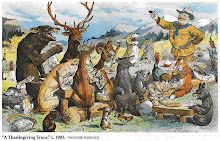Bobcat numbers appear to be on rise in
New Hampshire & Massachusett
By ANDREW WOLFE
Hunters and trappers killed 50 bobcats in Massachusetts last year, hitting the state's quota for the first
time since it was set in 1977, a state wildlife biologist said. Though cold comfort for those 50, the kills
bode well for the bobcats, which seem to be bouncing back in Massachusetts and New Hampshire,
biologists said. That doesn't mean you'll see one anytime soon.
"Bobcats are generally shy and elusive. You very rarely see them just walking around," Massachusetts
Fish and Game biologist Laura Hajduk told an audience of about 75 people who came to hear her talk
about bobcats recently at the Nashua River Watershed Association headquarters in Groton, Mass.
Bobcats are a top-line predator in New England. Humans aside, New Hampshire Fish and Game biologist
Pat Tate said recently, "There aren't any predators that prey on bobcats."
Because of their solitary and elusive nature, not much is known about the habits and lifestyle of bobcats
in New England. It's illegal to hunt them in New Hampshire, but wildlife biologists with the University of
New Hampshire and state Fish and Game Department have teamed up for a three-year study starting this
fall. New Hampshire biologists plan to focus their study in the regions around Keene and Plymouth, and
will begin by trapping 10 to 15 cats in each area, sedating and studying them and then releasing them with
radio tracking collars. A similar study is ongoing in Vermont.
"You can't just line them up and count them," Tate said. Adding later, "New England bobcats haven't been
studied at great length, because of their elusiveness and because of the cost."
"They don't call back like a lot of birds do," Hajduk said. Adding later, "They are very difficult to capture,
very difficult to handle." Biologists hope the study will give a better picture of bobcats around the state, and
also help gauge the effectiveness of a major wildlife corridor from the Quabbin Reservoir in Massachusetts
to Mount Cardigan in New Hampshire, Tate said.
Bobcats were wiped out of Massachusetts and most of New England during the colonial years and into
the 1800s, Hajduk said, along with beaver, wolves, cougar and elk. Bobcats began to return as farmers
migrated west and forest reclaimed their fields, she said. Bobcats were viewed as a nuisance during
most of the 20th century, however, and New Hampshire and Massachusetts paid bounties for their pelts
throughout most of the 1900s, creating a record of the population while trying to extirpate it.
"In the past, bobcats were viewed as varmints. They were predators that people did not want on the
landscape," Hajduk said. "They were something we needed to be rid of."
New Hampshire ended its bounty program in 1973, five years after Massachusetts, and outlawed bobcat
hunting in 1977, six years after Massachusetts opened season, according to MassWildlife and the New
Hampshire Bobcat Study Web site created by UNH ecology professor John Litvaitis. Now, bobcats may
be bouncing back. There have been about 50 bobcat sightings around New Hampshire in the last two
years, including three in Hudson, Tate said. Cars have killed about 30 bobcats on New Hampshire roads
in the past two years, including two in Merrimack, and one each in Amherst and Milford, Tate said.
Bobcats have been spotted in all but Boston and southeastern Massachusetts, Hajduk said, including
nine sightings in the last seven years within the Worcester city limits."We get some great reports when people
see a bobcat in Worcester," Hajduk said. "They are absolutely shocked."
Bobcats are New Hampshire and Massachusetts's only native wild cats (unconfirmed cougar sightings
excepted), biologists say. Lynx have been known to cross the Canadian border to visit northern New
Hampshire, but there are no known lynx breeding in the state, Tate said. Northern New Hampshire is the
northern edge of the bobcat's natural range, and the southern edge for the lynx, he said. (Bobcats are a
member of the lynx genus, and lynx-bobcat hybrids have been found in Minnesota, federal researchers
report).










No comments:
Post a Comment